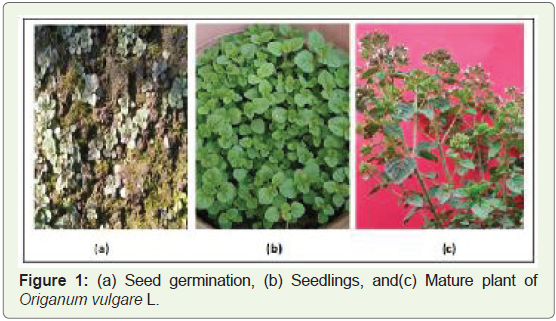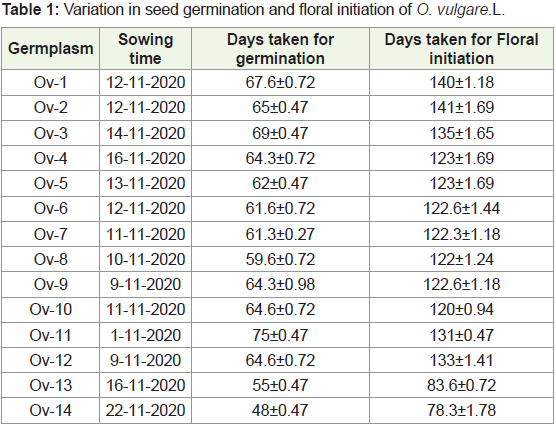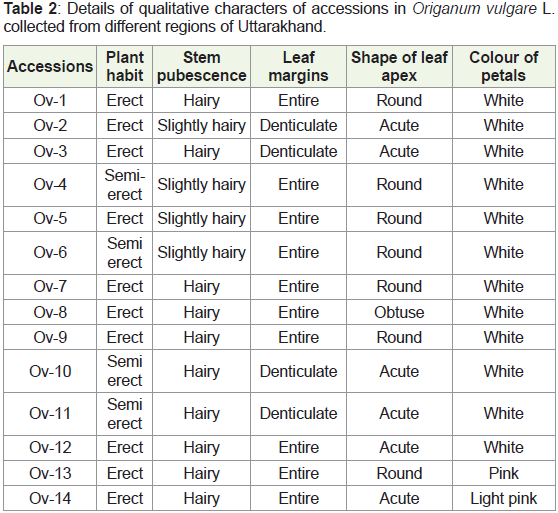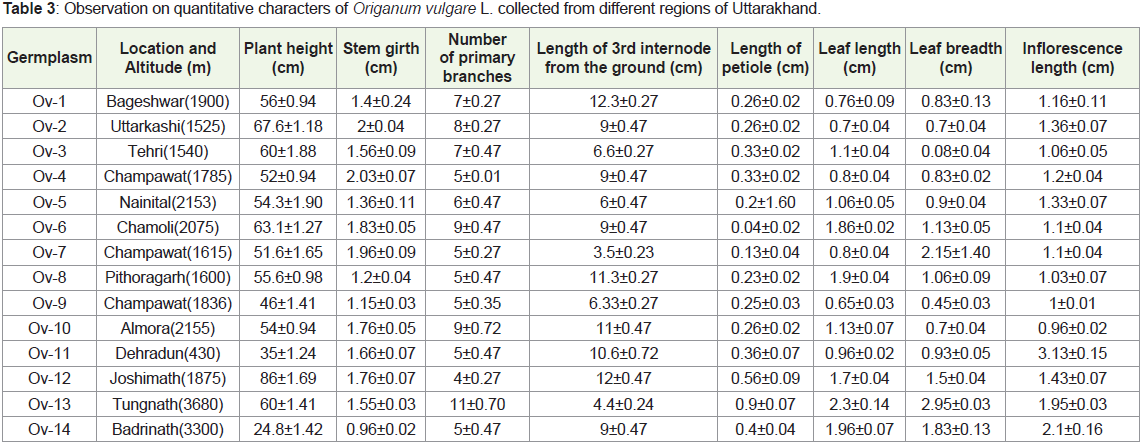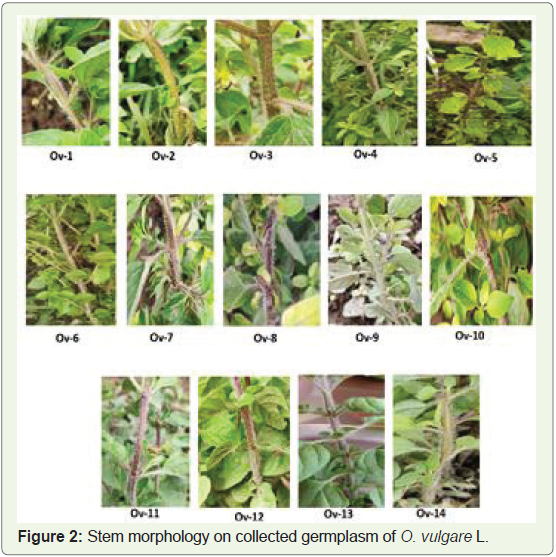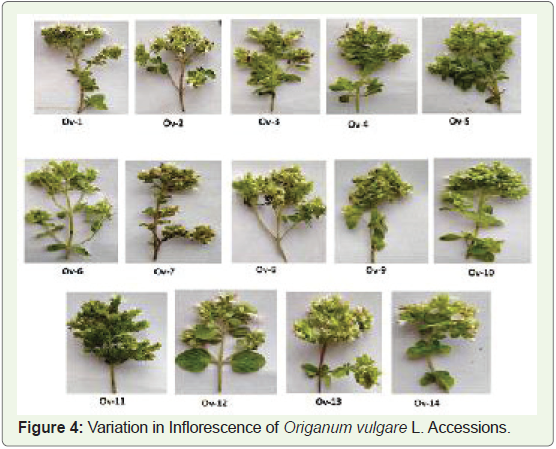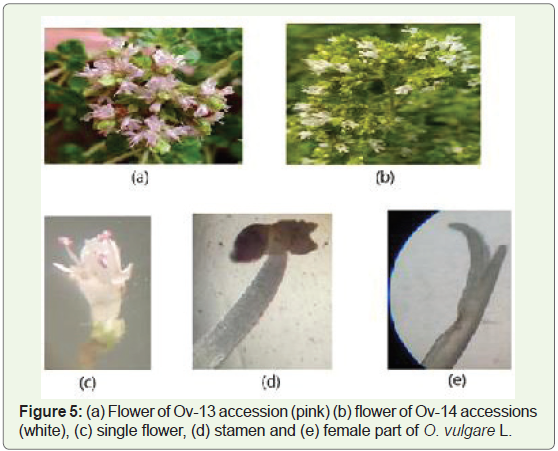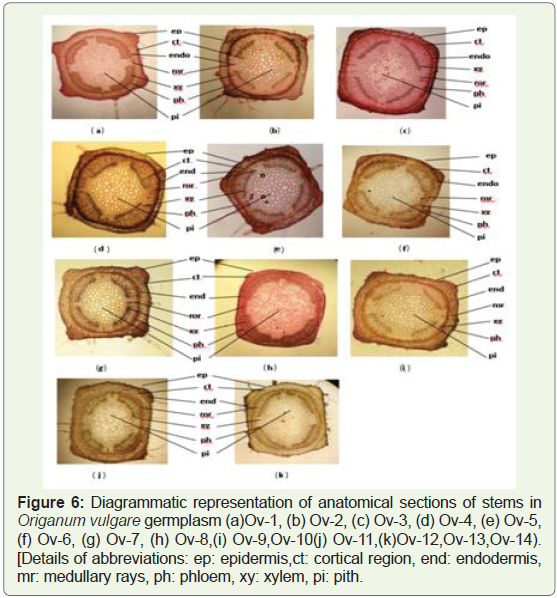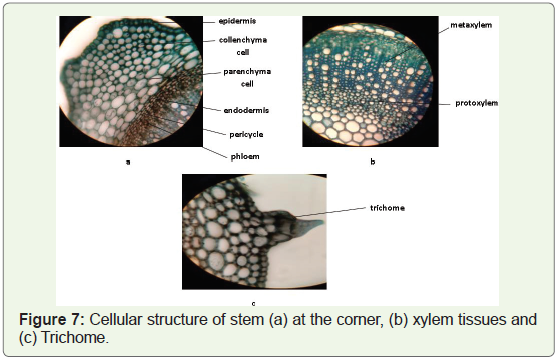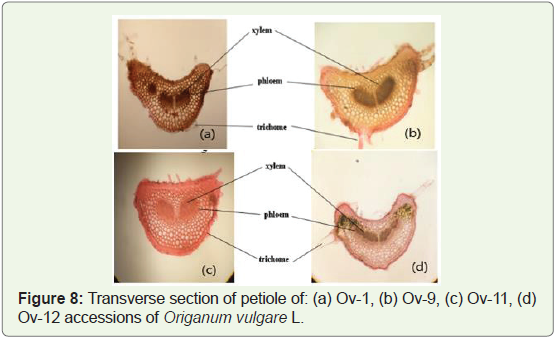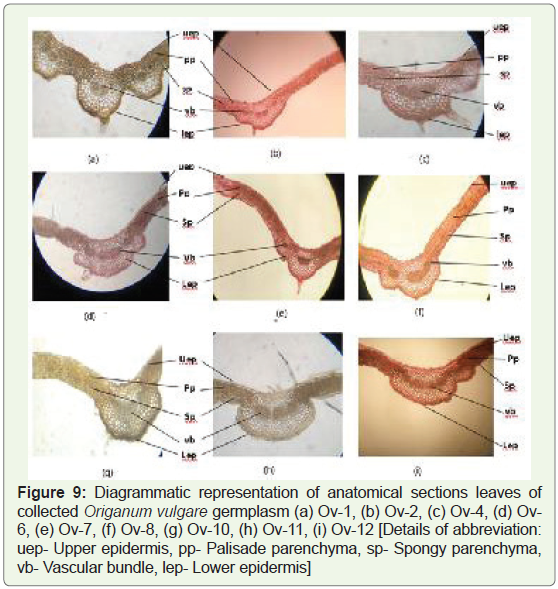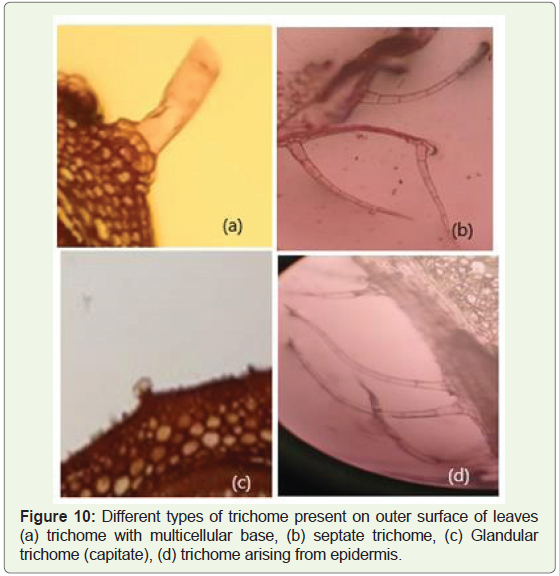Research Article
Morphological and Anatomical Characterization of Genotypes of Origanum vulgare L. in Uttarakhand
Maithani A1, Maithani U2 and Singh M1*
1Department of Botany, School of Basic and Applied Sciences, SGRR University, Patel Nager, Dehradun (248001) Uttarakhand,
India
2Government Degree College Narendra Nager, Uttarakhand
*Corresponding author: Singh M, Department of Botany, School of Basic and Applied Sciences, SGRR University,
Patel Nager, Dehradun (248001) Uttarakhand, India; Tel: 0135-2721763; E-mail: singhmaneesha2@gmail.com
Copyright: © Maithani A, et al. 2022. This is an open access article distributed under the Creative Commons Attribution License,
which permits unrestricted use, distribution, and reproduction in any medium, provided the original work is properly cited.
Article Information: Submission: 23/09/2022; Accepted: 15/11/2022; Published: 18/11/2022
Abstract
Badri tulsi (Origanum vulgare L.) is a spice, medicinal and aromatic perennial herb belongs to Lamiaceae family. This plant possesses diverse biological
potential due to variability in oil yield related traits.The present study has been conducted on morphological and anatomical characterisation of Origanum vulgare L. germplasm collected from Uttarakhand region.The present studies revealed that plants were generally perennial with erect type of habit in most
cases whereas semi erect habit were reported in 4 germplasm (Ov-4, Ov-6, Ov-11, Ov-12) collected from Champawat, Chamoli, Dehradun, Joshimath
districts respectively. Minimum plant height was reported in Ov-14 germplasm (24.8±1.42cm) collected from Badrinath whereas maximum plant height was
observed in Ov-12 (86±1.69cm) germplasm collected from Joshimath district. On leaf length characterization, the minimum leaf length was found in Ov-9
(0.65±0.03cm) while maximum leaf length was reported in germplasm Ov-13 (2.3±0.14cm).In anatomical investigation, transverse section of stem was
quadrangular and outer layer was covered with cuticle followed by epidermis with two types of trichome - simple and glandular. Maximum number of trichome
on the stem was observed in Ov-11 germplasm and minimum were in Ov-7 germplasm. In transverse section, leaves were covered with cuticle followed by
single layer of upper and lower epidermis. Thick cuticle was present in Ov-1, Ov-2 and Ov-12 accessions. Epidermis consists of uniseriate, multicellular long
simple and glandular trichome. Diacytic type of stomata was reported in both the surfaces of leaves in all studied germplasm. The findings of the present
studies revealed that morphological and anatomical characterization could be used as tools to distinguish the variability among the germplasm of Origanum vulgare L. collected from different regions of Uttarakhand, India. Thus, these studies will be useful in future for genetic enhancement and development of
varieties with high biomass yield, and desirable agronomic characters with high essential oil content in respect of the conservation of bio resources.
Keywords
Origanum vulgare L; Germplasm; Morphological characters; Anatomical features; Glandular trichome, Essential oil; Conservation
Introduction
Badri tulsi (Origanum vulgare L.) is a spice, medicinal and
aromatic perennial herb belongs to Lamiaceae family. The plant is
native to Europe and north of the African continent [1]. In India,
Origanum vulgare L. is grown in sub temperate and temperate region
especially in Himalayan region.
Badri tulsi is an extremely variable and polymorphic species due
to cross pollination and plasticity. Plants bear terminal corymbose
cyme with gynodioecious and male sterility condition having white
or purple flowers [2,3]. Plants with a higher essential oil content
(Origanum vulgare subsp. hirtum, Origanum vulgare subsp.
glandulosum and Origanum vulgare subsp. gracile) species are
characterized by the presence of carvacrol, thymol, p-cymene, and
γ-terpinene, while the minor constituents are sabinene, linalool,
borneol, and sesquiterpenes [4]. The essential oil composition varies according to environmental conditions, geographical area,
harvesting time, and stage of plant maturity [5]. The essential oil
of Origanum vulgare mostly possess anti-bacterial, anti-viral, antiseptic,
anti-microbial, anti-oxidant, anti-fungal, anti-bacterial, anticoagulant,
energetic action, flavouring properties [6]. Traditionally,
plant possess several uses like indigestions, diarrhoea, cough, remedy
against pruritus, headaches, depression, stomachic, carminative,
expectorant, and emmenagogue, respiratory and digestive disorders
and ointments to treat wounds [5,7-9]. Besides this, Origanum
subspecies are widely used in pharmaceutical industry and also
serve as a food, preservative and flavouring, cosmetic ingredient
and most importantly as a culinary herb [10]. From ancient times in
Uttarakhand, India, Badri tulsi serve as prasaad to Badrinath temple
as replica of Maa Lakshmi, who is the half dhangini of lord Narayan.
According to the literature review, badri tulsi has an amazing ability
to combat climate change as it can absorb 12 percent more carbon
than ordinary basil and other plants. In Badrinath area more than
1500 people get employment from Badri tulsi, which is the indication
of overexploitation of it in hilly regions of Uttarakhand, due to which
it can become threat in future.
Traditionally, plant taxonomy dependent on morphological and
microscopic characterization of plants. In recent years, morphological
and anatomical characterization of Lamiaceae family members is
useful for determining the productivity of essential oil along with
taxonomical characterization. In this regard, Several studies have
been conducted and reported on morphological, microscopic and
oil yield characterization of Lamiaceae members. The variability
among the populations of Origanum vulgare L. with regard to morphological,
histo-chemical characters and composition of essential oil which
were basically confined to European countries whereas in India less
contribution in these aspects [11-19].
Therefore, the present study was conducted to evaluate variability
among the genotypes of Origanum vulgare L. collected from different
geographical areas of Uttarakhand on the basis of morphological and
anatomical features for enhancing the oil productivity in respect to
ex-situ conservation.
Materials & Methods
Study area:
The present investigation was carried out at Botany Laboratory in
Department of Botany, School of Basic and Applied Sciences and at
Agriculture field of School of Agricultural Sciences, Shri Guru Ram
Rai University, Patel Nagar, Dehradun, Uttarakhand. The state of
Uttarakhand, 27th State of republic of India lies between 28053’24”
and 31027’50” N latitudes and between 77034’27” and 81002’22” E
longitude. The state covers an area of 53,483 Km2, of which 51,000
Km2 comes under the Himalayan region. The state has 13 districts.
One of the district and capital of Uttarakhand, Dehradun is nested
in the mountain ranges of the Himalaya, is one of the oldest cities
of India. Dehradun is situated at latitude 300316’ N and longitude
78003219’ E, covering an area of 300 sq. Km with an elevation of 650
m above the sea level. Dehradun district is situated in the north-west
corner of the state. The average annual rain fall of 2073.mm in the
city. The district bordered by the Himalayas in the north, Rajaji range of the Shivalik hills and lesser Himalayas to the south, the river Ganga
to east, and the Yamuna river to the west.Collection and sowing of samples:
A total 14 germplasm of Origanum vulgare with their seeds randomly
collected from the natural habitat of different locations of Uttarakhand
and from Centre for Aromatic Plants, Selaqui Dehradun, during
September to November, 2020. Some germplasm collected from
National Bureau of Plant Genetic Resources, Nainital, Uttarakhand.
The collected plant material identified with the help of available
literature.Raised beds(1mx1m) were prepared and seeds were sown to
raise the seedlings of the collected germplasm. The seeds of Origanum vulgare were sown in the month of November 2020. Agriculture
practices such as irrigation, fertilizer and weeding as per requirement
were followed for proper growth of the plants.Evaluation and collection of morphological data:
Morphological characterization has been conducted among
the collected germplasm during vegetative and flowering stage on
qualitative and quantitative parameters such as plant height, length of
third internode from the ground, stem girth, leaf length, leaf breadth,
inflorescence length, number of primary and secondary branches,
length of petiole, shape of leaf, leaf arrangement, shape of leaf apex
and leaf margin.Anatomical study:
Anatomical investigations were carried out on the crosssections
of stems, petiole and leaves. The fresh plant parts preserved
in alcoholic acetic solutions which was prepared by the mixing
of 50% alcohol, 40% formalin, 2% acetic acid. The preserved plant
material was subjected for microscopic studies. All sections were
prepared manually and Preserved as well as fresh material was used
for anatomical characterization by double staining (safranin and
fast green). The transverse section of stem, petiole and leaves were
dehydrated in 30%, 50%, 70% and 95% solution of ethanol. For
double staining safranin and fast green was used. Double staining was
done so that the living tissues can be differentiated from the dead one
and at last this double stained section was fixed in the slide by the use
of Canada balsam and the photographs of the sections were taken for
detail cellular characterization.Result & Discussion
Badri tulsi is a multipurpose aromatic perennial herb. The main
constituants of essential oil of Origanum were carvacrol and/or
thymol. Oil possesses various biological activities like anti-bacterial,
anti-viral, anti-septic, anti-microbial, anti-oxidant etc. In view of
wide pharmaceutical and traditional values, the present study has
been conducted for morphological and anatomical characterization
of genotypes of Origanum vulgare L. collected from different locations
of Uttarakhand state in India for its conservation. The findings of the
present studies are as follows:
Germplasm characterisation on the basis of seed germination and
floral initiation:
The collected seeds of Origanum vulgare L. germplasm was sown
in the month of November, 2020. Initiation of seed germination were
reported in January 2021.The rate of seed germination varies from
48±0.47 to75±0.47 days. Late Germination of seeds were reported
has taken 75±0.47 days in Ov-11 germplasm (75±0.47 days which
was) collected from Dehradun whereas early the quick germination
(48±0.47days) was reported in Ov-14 germplasm (48±0.47days)
collected from Badrinath. On the basis of floral initiation, the days
varied from 78.3±1.78 to 141±1.69 days. Early flower initiation
was recorded in Ov-14 (78.3±1.78days) germplasm collected from
Badrinath while late flowering was recorded in Ov-2 germplasm
(141±1.69 days) collected from Uttarkashi (Table 1, Figure 1). Similar
type of study was conducted by Ojha et al., in 2014 on 33 accession
of Origanum collected from different localities of Uttarakhand and
he observed that floral initiation was varied from 80.17±0.76 days to
141.17±0.44 days [16].
Morphological characterization:
On the basis of morphological characterisation in the present
study, It was reported that plants were generally perennial with erect
type of habit in 10 germplasm whereas semi erect habit were reported
noticed in 4 germplasm (Ov-4, Ov-6, Ov-11,Ov-12) were collected
from Champawat, Chamoli, Dehradun, Joshimath respectively
(Table 2).
Table 2: Details of qualitative characters of accessions in Origanum vulgare L.
collected from different regions of Uttarakhand.
In the present study, height of plants varied from 24.8±1.42cmto
86±1.69cm. Minimum plant height was found in Ov-14 germplasm (24.8±1.42cm) collected from Badrinath whereas maximum plant
height was observed in Ov-12 (86±1.69cm) germplasm collected
from Joshimath (Table 3). These studies revealed the effect of
altitude on the growth of the plant related to the soil and climatic
factors varying seasonally and attitudinally. Similar studies on plant
height of Oregano has been conducted by Sivicka et al.,(2019) on
44 germplasm of Origanum vulgare from Latvia [19]. He observed that
plant height of Oregano varied from 50.1 to 85.0 cm in 2012, from
45.0 to 75.2 cm in 2013, from 30 to 85.9 cm in 2014. In average, it
was 68.14 cm in 2012, 59.7 cm in 2013, 74.12 cm in 2014. Ojha et
al., (2014) revealed that the plant height varied from 28.17±0.78cm
to 77.51±7.17cm on33 accessions from different geographical
conditions of Uttarakhand [16]. Olga et al., in 2018 determine the
diversity of 14 different Ooregano and he observed that plant height
varied from 52.13 to 88.66cm [4]. Weglarz et al., in 2020 studied the
difference between two subspecies: Origanum vulgare L. subsp. hirtum(link)
letswaart(Greek oregano) and Origanum vulgare L. subsp. vulgare (common
Oregano) in central Europe, and reported that the plant height
in common Oregano was 36.11 cm± 1.93 while in Greek oregano,
it was 26.15 ± 1.86cm [18]. Greek oregano plants grown in Poland
were about 10 cm lower than common oregano plants. For instance,
common oregano plant’s height ranged from 18 to 59 cm while in
Greek oregano, it varies from 67.8 to 79.9 cm [15,20-23]. Beemnet
et al. in 2014 studied the morphological characteristics of Oregano
(Origanum vulgare L.) in Ethiopia and reported that the average plant
height were 34.93 to 39.87 cm [21].
Table 3: Observation on quantitative characters of Origanum vulgare L. collected from different regions of Uttarakhand.
In the present study, effect of altitude on the growth of the plant
and other morphological character has been studied. On plant height
characterization, maximum plant height (46±1.41 to 86±1.69cm) was
observed in between 1000-2000m altitude whereas the minimum
height (24.8±1.42 to 60±1.41) was observed in between 3000-3550m
(Table 3). Similar findings has been reported by Ojha et al. in 2014 that
maximum plant height (35 to 77.5cm) was observed in between
2000-3000m altitude whereas the minimum plant height (28-31cm)
was observed in between 3000-3550m [16]. Effect of altitude on the growth of plants was also observed by Krishnan et al.in 2000 reported
that variations in the morphological parameters such as plant height
related height to the soil and climatic factors varying seasonally and
attitudinally [22]. Rajasekaran et al. (1998) observed increase in shoot
length with increasing altitude in the plants of same species while
grown at an altitudinal gradient [23].
Characterization on the basis of stem colour pigmentation,
pigmentation varied from light green (Ov-2, Ov-3,Ov-14,Ov-13),
green (Ov-9), light brown (Ov-6, Ov-10, Ov-11, Ov-12 and dark
brown (Ov-1,Ov-4, Ov-5, Ov-6, Ov-7,Ov-8) (Figure 2). Similar
type of studies has been conducted by Olga et al. in 2018 to evaluate
the diversity of 14 different oregano on the basis of colour of stem.
Regarding stem pubescence, majority of accessions had slightly hairy
stems whereas in two accessions were distinguished by hairy ones
(Table 2).Weglarz et al. in 2020 reported that Common Oregano
was characterized by erect type of growth and ligneous, slightly hairy
stems with stem colour from dark green to red [18]. The number of
primary branches ranges from 5±0.27 to 11±0.70. Minimum primary
branches were found in Ov-12 (5±0.27) whereas the maximum
primary branches were observed in Ov-13(11±0.70) (Table 3).
In most of collected accessions, petiole length varied from
0.56±0.09cm to 0.04±0.02cm. The minimum petiole length was
0.04±0.02 cm found in Ov-6 germplasm whereas maximum petiole
length was found in Ov-12 germplasm (0.56±0.09cm) (Table 3). Stem
girth varied from 0.96±0.02cm to 2.03±0.07cm. Minimum stem girth
found in germplasm Ov-14 (0.96±0.02cm) whereas maximum stem
girth was found in Ov-4 (2.03±0.07) germplasm (Table 3). Most of
the stem were covered with white colour hairs. Simple and glandular
trichome were found in selected germplasm.
On the basis of leaf morphology,the shape of leaves were ovate in
all studied germplasm. The pigmentation of leaves was either green or,
dark green. The variation has been reported in leaf apex and margins
of leaf. Leaf apex was generally rounded or, and acute, 7 germplasm
with round apex and 6 were with acute types has been reported in
the present study. Leaf margin was either entire or, denticulate. 10
germplasm found with entire margin and 4 were with denticulate leaf
margin and one with obtuse type (Figure 3, Table 2).
Leaf length varied from 0.65±0.03cm to 2.3±0.14cm. The minimum
leaf length was found in Ov-9 (0.65±0.03cm) while maximum leaf
length was reported in germplasm Ov-13 (2.3±0.14cm). Leaf breadth
was varied from 2.95±0.03cm to 0.08±0.04cm. Minimum leaf breadth
was reported in germplasm Ov-3 (0.08±0.04cm) whereas maximum
leaf breadth was found in germplasm Ov-13 (2.95±0.03cm) (Figure 3, Table 3). Studies on leaf characters has been conducted by Ojha et al., in 2014 and other scientist. Their studies revealed that leaf
length ranges from 1.36±0.12cm to 2.50±0.07cm. and the number of
primary branches were ranging from 5 to 55. [16]. In most of collected
accession, leaves were ovate, broadly ovate, 10-44 mm long and 5-25
mm wide, and phyllotaxy of the leaves were opposite to each other
on the stem and the flowers were terminal corymbose cyme [16-18].
In most of germplasm, Inflorescence were terminal or, axillary
corymbose. The inflorescence length was varying from 0.96±0.02cm
to 3.13±0.15cm (Figure 4, Table 3). Flowers were sessile, small,
5-7mm long, bracts were green and overlapping the calyx. Flowers
were generally white and pink in colour (Figure 5). 12 accessions were
found with white colour flower whereas 2 accessions with pink flower
(Table 2).
Anatomical Characterization
Study:
Different accessions of Origanum vulgare have been characterised on the basis of anatomical character of plant parts such as stem, leaf
and petiole as follows:Stem:
The shape of stem was quadrangular which the characteristic
feature of Lamiaceae family.Outermost layer was covered with
cuticle followed by epidermis withtwo types of trichome- simple and
glandular. Maximum number of trichome on the stem were observed
in Ov-11 germplasm and minimum were in Ov-7 germplasm.
Epidermiswas followed by 5-8 cortical layers generally made up
of parenchymatous cells. Thick cortical layer was observed in Ov-
12(6-8 layered) and thin cortical layer found in Ov-14 (3-4 layered)
germplasm. Collenchyma cells basically present at the corners of
the stem. Well-developed notch with smaller collenchyma cells
were presents in Ov-7, Ov-1 and Ov-9 germplasm. Single layer
of endodermis followed by parenchymatous pericycle layer was
observed. The central region of stem consists of vascular bundles i.e.
xylem, phloem and followed by pith. The phloem includes sieve-tubes
and phloem parenchyma. Cambium was present in distinct in patches.
The xylem was differently structured; the primary xylem contains
vessels placed in radial rows separated by cellulosic parenchyma cells,
the secondary xylem, much thicker has vessels dispersed in radial rows
too, but separated by libriform fibres. Xylem vessels were arranged in
four groups connected with narrow band of xylem tissue. Maximum
number of xylem vessels were found in Ov-12(36 rows) accession and
minimum number of xylem vessels were found in Ov-14(18 rows)
germplasm. Central portion i.e. was occupied with parenchymatous
cells.Medullary rays made up of parenchymatous cells varied from
18-36 rows. Maximum medullary rays were found in Ov-12
accession(36 rows) whereas minimum number of medullary rays
were found in Ov-14 (18 rows) germplasm (Figure 6). In all studied accessions, vascular bundles were arranged in four different patches
and vascular bundle were conjoint collateral, endarch and open
type (Figures 6,7). Similar type of study was on Origanum plant in
Uttarakhand done by Ojha et al., in 2014 [16].
Figure 6: Diagrammatic representation of anatomical sections of stems in
Origanum vulgare germplasm (a)Ov-1, (b) Ov-2, (c) Ov-3, (d) Ov-4, (e) Ov-5,
(f) Ov-6, (g) Ov-7, (h) Ov-8,(i) Ov-9,Ov-10(j) Ov-11,(k)Ov-12,Ov-13,Ov-14).
[Details of abbreviations: ep: epidermis,ct: cortical region, end: endodermis,
mr: medullary rays, ph: phloem, xy: xylem, pi: pith.
Epidermal structures and stomatal ontogeny of some medicinal
plants have been done by many scientists and reported that epidermal
and cuticular traits of plants like epidermal cells, size and shape of
trichomes and number of vascular bundles could serve as vital tools
in solving taxonomic problems in Angiosperms [24-26].
Petiole:
The petiole shape was sulcate with obtuse margins in all the
selected accessions. Single layered epidermal cells were present in
both upper and lower layer. The surface was covered with cuticle.
Thick cuticle was present in Ov-11 and Ov-12 germplasm whereas
thin cuticle was present in Ov-1, Ov-9 germplasm. Multi-layered
collenchyma cells were present at the corner regions. The vascular
bundles were distributed in the parenchyma tissues. Petiole consists of
2-3 vascular bundle patches. Two vascular bundle patches were found
in Ov-1, Ov-11 accession, whereas three vascular bundle patches
were found in Ov-9 accession with half circle shape. The vascular
bundles were arc shaped in Ov-12 accession. Well-developed notch
was found in Ov-9 and Ov-12 accession (Figure 7 & 8). Similar types of
vascular bundles were also reported in Ocimum [27]. The shape of
the petiole and central vascular bundle has diagnostic value in species
characterization in members of Lamiaceae family [28].
Figure 8: Transverse section of petiole of: (a) Ov-1, (b) Ov-9, (c) Ov-11, (d)
Ov-12 accessions of Origanum vulgare L.
Leaves:
In transverse section, leaves were covered with cuticle followed by
single layer of upper and lower epidermis. Thick cuticle was present
in Ov-1, Ov-2 and Ov-12 accessions. Epidermis consists of uniseriate,
multicellular long simple and glandular trichomes. Beneath the
upper epidermis, palisade parenchyma and spongy parenchyma
were present. Single layered palisade parenchyma was present in Ov-
1, Ov-2, Ov-3, Ov-11 accession. 4 to 5 layered spongy parenchyma
were present in all the studied accessions. The vascular bundles were
present in 2 to 3 different patches. Two vascular bundle patches were
found in Ov-1, Ov-4, Ov-3 and three vascular bundle patches were
found in Ov-2, Ov-5, Ov-6, Ov-7, Ov-8, Ov-9, Ov-10, Ov-11 and Ov-
12 germplasm (Figure 9). Diacytic type of stomata was reported in
both the surfaces of leaves in all studied germplasm.
Figure 9: Diagrammatic representation of anatomical sections leaves of
collected Origanum vulgare germplasm (a) Ov-1, (b) Ov-2, (c) Ov-4, (d) Ov-
6, (e) Ov-7, (f) Ov-8, (g) Ov-10, (h) Ov-11, (i) Ov-12 [Details of abbreviation:
uep- Upper epidermis, pp- Palisade parenchyma, sp- Spongy parenchyma,
vb- Vascular bundle, lep- Lower epidermis]
Similar type of studies has been conducted by Ojha et al., (2014).
According to his studies on d anatomical features of Oregano, leaf
was dorsiventral, diacytic type of stomata, trichome were simple or
covering type and glandular type. The upper and lower epidermal cells
were found to be wavy with thin cell wall. Vascular bundle is restricted
to the midrib region and comprises of collateral arrangement of
xylem and phloem [16].
Trichome:
Trichomes are hairlike unicellular and multicellular appendages
emerge from the surface of the leaves and stem. The role of trichomes is
to help in secretion of essential oil, absorption of water, ion exchange,
protection etc [29]. In Origanum subspecies and in other members
of Lamiaceae family, glandular trichome was multicellular epidermal
glands responsible for storage of essential oil. Two different types of
glands were recognized on the epidermis of Origanum species i.e.,
peltate and capitate types. The glandular trichomes are built of one basal cell, one stalk cell and a multi-cellular head, which synthesized
essential oil after that it transferred to subcuticular area [30,31].In the present studies on Origanum vulgare plants, nonglandular
trichome and glandular trichome were found in stem
and leaves. Non- glandular trichomes were unbranched, uniseriate,
Hooked, Multicellular and generally originated from epidermal cells.
Glandular trichomes were unicellular and uniseriate. These trichomes
can secrete variety of secondary metabolites. Most of the trichomes
present on stem and leaves were with multi cellular base. Glandular
trichome were capitate type. Maximum number of non- glandular
trichomes and glandular trichomes were found in Ov-11, Ov-12 and
Ov-6,Ov-11accession respectively (Figure 10).
Figure 10: Different types of trichome present on outer surface of leaves
(a) trichome with multicellular base, (b) septate trichome, (c) Glandular
trichome (capitate), (d) trichome arising from epidermis.
In some genera of Lamiaceae family, trichrome morphology is
helpful in infrageneric as well as at specific levels classification [31].
Weglaz et al. in2020reported that Greek oregano was distinguished
by visibly higher number of glandular trichomes on the leaves (up to
4.85 per 1 mm2)followed by higher content of essential oil in the herb
in comparison of common oregano[18]. The factors that influence the
density and glandular trichomes, and, thus, directly impact the yield
of essential oil, are defined both genetically and environmentally.
Reduced water and nitrogen supply augment the density of peltate
trichomes, while plant density does not affect the number of glandular
hairs per leaf surface unit [32]. Kofidis et al., (2003) investigates the
structural variations of Origanum vulgare leaves during growing
season at native plants from different altitude (200 m, 950 m and 1760
m). The glandular hairs are more numerous on the lower leaf surface
than on the upper one at 200 m altitude. In the leaves of lowland (200
m) plants, glandular hairs are denser compared with those of the mid
and upland (950 m, 1760 m) plants, for both the upper and lower
surface, which helps in pollination [32-34].
Conclusion
The findings of the present study on morphological and anatomical
characterization of different plant parts could be used
as taxonomical tools to distinguish the variability among the
germplasm of Origanum vulgare L. collected from different regions
of Uttarakhand, India. Thus, these studies will be useful in future for
genetic enhancement and development of varieties with high biomass
yield, and desirable agronomic characters with high essential oil
content in respect of the conservation of bio resources.
Acknowledgement
Authors are grateful to Prof.(Dr.) U.S. Rawat, Vice Chancellor,
ShriGuru Ram Rai University, Patel Nagar, Dehradun for his kind
support and suggestions.

